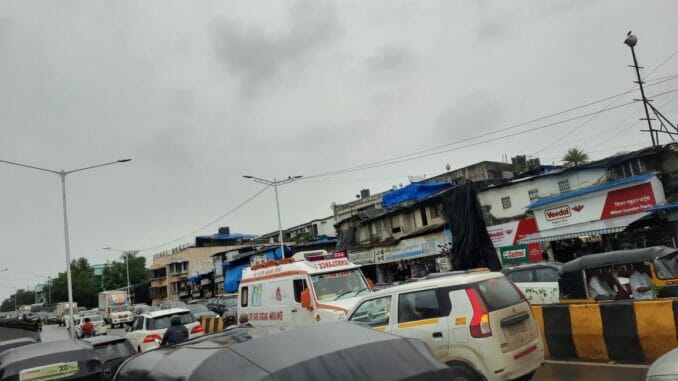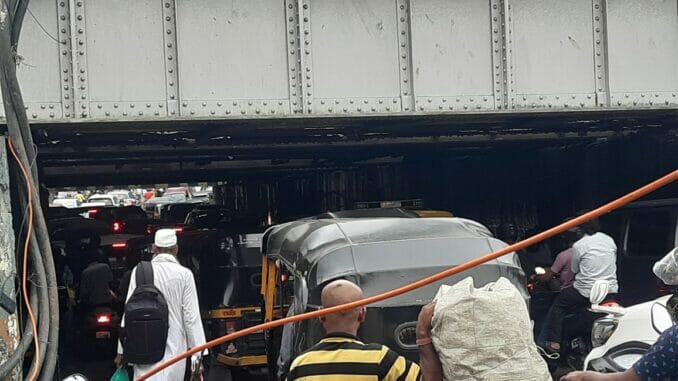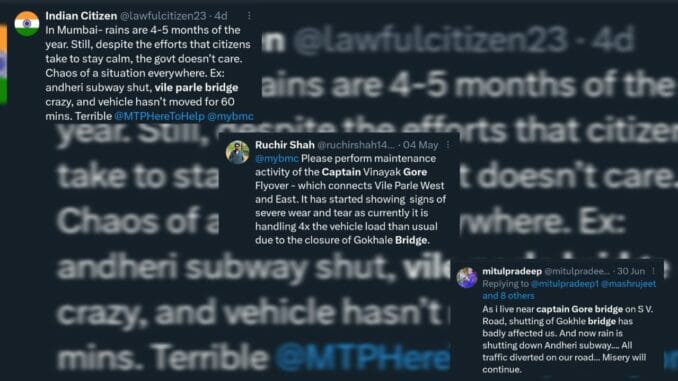When the first rains lashed Mumbai in the last week of June, the Andheri subway was flooded, waterlogged and completely shut. This is the best alternative to the now-closed Gopal Krishna Gokhale bridge for East-West connectivity. Gokhale bridge closed last year after it was found to be structurally weak. “Difficulties have multiplied, because of the delay in construction of the Gokhale bridge. It creates havoc in Vile parle, Andheri and Jogeshwari because of the unending traffic snarls, says Vinod Cherian, a daily commuter.
The Gokhale bridge, which closed in November 2022, was supposed to open, at least partially by May 2023, before monsoon. However, the deadline has been extended. The alternatives that the commuters use for Gokhale bridge are Andheri subway, Captain Gore bridge, Thackeray bridge and Milan subway. Commuters are already spending hours in this traffic on a daily basis, and it is getting worse with rains.
The never ending traffic
Recently when Citizen Matters visited Milan subway and Andheri subway to understand the condition, the traffic towards Milan Bridge did not move at all for 30 minutes. An ambulance was stuck in the traffic. The Andheri subway too had chock-a-block traffic. This was on a day when it didn’t rain heavily. The situation is much worse, when it rains. The correspondent did not see Mumbai Traffic Police at the Milan and Andheri subway that day.

“Most of the time the Mumbai traffic police is not present on ground to regulate traffic, the citizens come out and do it themselves. If a VIP visits Andheri at that time, then we can see them regulating traffic. Otherwise they only know how to take fines from people,” says Vinod, exasperated with the every day struggle.
Andheri subway, the major issue of Mumbai
When asked about the biggest challenge due to the closure of the Gokhale bridge, a BMC official, who did not want to be identified, said, “Andheri subway has been the biggest issue for monsoon, not only for the K west ward but also for the entire Mumbai city”. Not one monsoon has passed, when the Andheri subway has not been shut. When heavy rains occur, the closest alternative near Gokhale bridge vanishes in an hour and is of no use.

When Andheri subway shuts down, the traffic is diverted to Captain Vinayak Gore bridge also known as Vile Parle bridge. It is a single lane bridge (to and fro), the traffic slows down considerably. The other alternative located in Jogeshwari is the Thackeray bridge.
When Citizen Matters interviewed a few daily commuters, the majority of them said that taking the Milan bridge is like holding your ear from the back of your head. Even though the Milan bridge has two lanes, it is too far for commuters, who stay in Andheri.
Either the roads are narrow or flood-prone or both. “Heavy vehicles such as trucks with construction material are not suitable on the Captain Vinayak Gore bridge. The bridge is not equipped to take such a heavy load. Milan and Thackery bridge are better options,” says Dhaval Shah, director of Lokhandwala Oshiwara Citizen’s Association.
Is BMC really prepared for the monsoon?
The BMC official said that they have a fixed water level marking to assess flood situation. When the water level rises over that mark, the teams are alerted in Andheri east and west. The BMC claims to have identified the location of flooding spots for the installation of pumps.
In the K west area, the pumps have been installed in 10 such spots. Veera Desai Gundecha symphony, Off Veera Desai road near Savera society, Singh Compound Behram Baug, Veera Desai Sidbi apartment, Teacher colony, Versova cemetery, stand by K west ward office, Illa darshan building, Gilbert hill each of these locations has one water pump installed. Andheri subway has three pumps and Andheri market has two.

Despite the preparedness claims by the BMC, the civic body seems to be failing already. From the start of the monsoon the social media is flooded with citizens’ complaints about their commuting experience. The commuters are calling out the authorities for the delay of Gokhale bridge. The citizens have also flagged the difficulties in taking alternative routes.
Read More: How citizens can fight for road infrastructure in the city
Is there a solution to this mess?
Samarth Das, urban planner and architect pointed to lack of management from the civic body. “Multiple agencies within the BMC lack coordination and will to facilitate quality of life for the citizens of Mumbai. To be frank, the BMC has very capable engineers and resources, who can make a radical change in the way our city functions. We tend to hide behind the shadow of this romantic idea of Mumbaikar being resilient. It has now become a joke and authorities have started taking advantage of that resilience.”
When asked about solution for the Andheri subway issues, Das said, “Some situations don’t have solutions, when you have gone completely against nature. You built infrastructure through engineering solutions, which were equipped to handle weather conditions prevalent at that time. But frankly they are completely obsolete today, with the climate change driven situations such as extreme rainfall and sea level rise.
He emphasised that nature-led planning has to be the way forward. “We are surrounded by water and we have a vast diversity of places like national parks, rivers and wetlands. Till today no importance was given to these elements of nature, which are absolutely critical for the long term sustainability of our city itself.”
However, even as urgent every day maintenance and repairs of roads, bridges and flyovers remains primary responsibility of the administration, and even as commuters continue to suffer on a daily basis, long term vision and nature-led development seems a distant possibility right now.